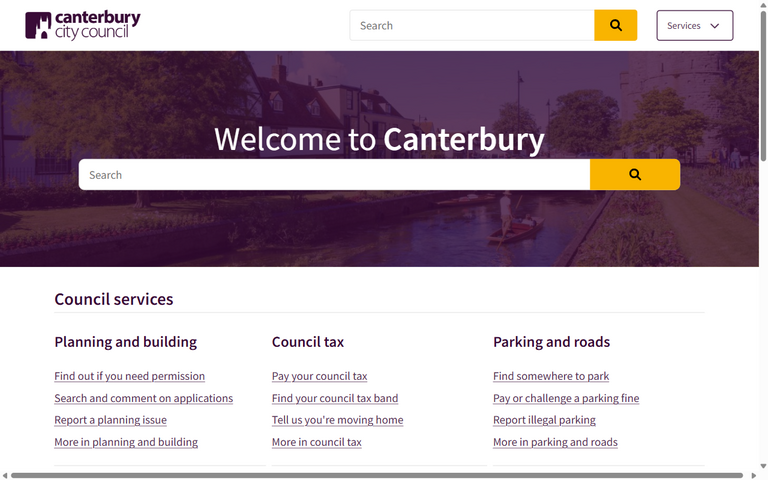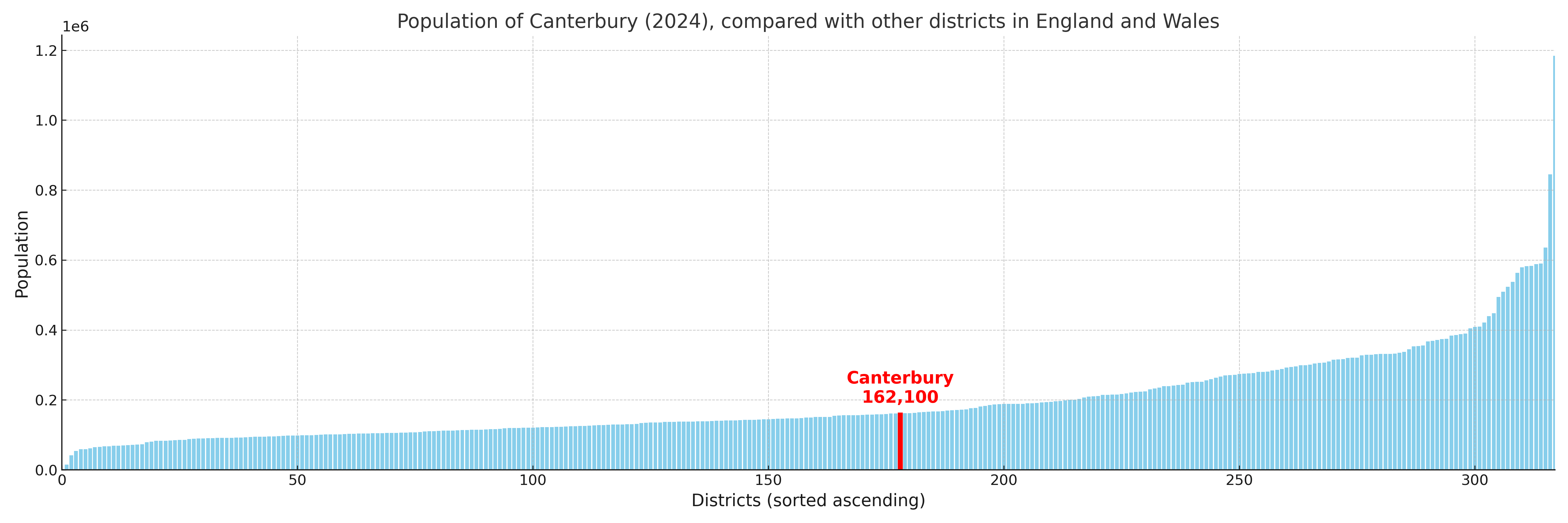Canterbury
§ This page gives an overview of the Canterbury local authority district, bringing together key facts, maps, and data to help you quickly understand the area. One of 361 district profiles on Baseview.
Overview ⁞ Canterbury, in east Kent, is a historic cathedral city, part of a UNESCO World Heritage Site, with medieval streets, the River Stour, and the dominant Canterbury Cathedral. The city centre blends Roman walls, historic churches, and modern amenities, while the wider district includes coastal towns such as Whitstable, famed for its oysters and maritime heritage, and Herne Bay with its seafront and pier. Rolling countryside, woodland, and villages surround the urban centres, giving Canterbury a diverse landscape of coast, heritage, and farmland.
Canterbury Boundary Map
This map shows the official boundary of the Canterbury local authority district, based on the latest geographic data published by the Office for National Statistics (ONS). It provides a clear view of the district’s extent and helps you understand how the area fits within the wider regional and national landscape.
Contains OS data © Crown copyright and database right 2025. Source: Office for National Statistics licensed under the Open Government Licence v3.0.
The administrative boundary of Canterbury can also be viewed on OpenStreetMap: District Boundary of Canterbury.
Key Facts about Canterbury
What region is Canterbury in? Canterbury is in the South East of England, a region within the UK.
What county is Canterbury in? Canterbury is located in the county of Kent.
Is Canterbury a city? Yes, Canterbury is a city. Canterbury holds official city status as one of the 76 designated cities in the UK.
Who governs Canterbury? The local authority for this district is: Canterbury City Council - responsible for district-level services. Since Kent is a two-tier area, county-level services are handled by: Kent County Council.
▶ Official website of Canterbury City Council 🔗 canterbury.gov.uk

Which police force covers Canterbury? Policing in Canterbury is provided by Kent Police 🔗 kent.police.uk, which serves 13 local authority districts: Ashford ⁞ Canterbury ⁞ Dartford ⁞ Dover ⁞ Folkestone and Hythe ⁞ Gravesham ⁞ Maidstone ⁞ Medway ⁞ Sevenoaks ⁞ Swale ⁞ Thanet ⁞ Tonbridge and Malling ⁞ Tunbridge Wells.
Constituencies in Canterbury
Canterbury is divided into 2 parliamentary constituencies, listed below in alphabetical order.
A constituency is a specific geographical area that elects one Member of Parliament (MP) to represent them in the House of Commons. The United Kingdom is divided into 650 parliamentary constituencies. We have this list page for easy browsing of all UK parliamentary constituencies: List of Constituencies.
Wards in Canterbury
Canterbury is divided into 21 wards, listed below in alphabetical order.
- Barton
- Beltinge
- Blean Forest
- Chartham & Stone Street
- Chestfield
- Gorrell
- Greenhill
- Herne & Broomfield
- Heron
- Little Stour & Adisham
- Nailbourne
- Northgate
- Reculver
- Seasalter
- St Stephen's
- Sturry
- Swalecliffe
- Tankerton
- West Bay
- Westgate
- Wincheap
In the UK, a ward is a subdivision of a local authority area, used mainly for electoral and statistical purposes. Defined by the ONS, wards represent the primary unit for local elections, each returning one or more councillors to the local council. Wards are also used as a key geography for presenting population and census data.
Parishes in Canterbury
Canterbury is part-parished: 27 civil parishes (listed A-Z below) alongside 2 unparished areas.
- Adisham
- Barham
- Bekesbourne-with-Patrixbourne
- Bishopsbourne
- Blean
- Bridge
- Chartham
- Chestfield
- Chislet
- Fordwich
- Hackington
- Harbledown and Rough Common
- Herne and Broomfield
- Hersden
- Hoath
- Ickham and Well
- Kingston
- Littlebourne
- Lower Hardres and Nackington
- Petham
- Sturry
- Thanington
- Upper Hardres
- Waltham
- Westbere
- Wickhambreaux
- Womenswold
A civil parish is the lowest tier of local government in England, used for villages, small towns, and suburbs. They have their own local authority, either a parish council or a parish meeting, which provides local services like managing parks, allotments, and streetlights, and represents the community's views to larger councils.
Built-up Areas in Canterbury
Canterbury covers 27 built-up areas, listed below in alphabetical order.
- Adisham
- Aylesham *
- Barham
- Bishopsbourne
- Blean
- Bossingham *
- Bridge
- Broad Oak (Canterbury)
- Canterbury
- Chartham
- Chilham *
- Herne
- Herne Bay
- Hersden
- Kingston (Canterbury)
- Littlebourne
- Lower Hardres and Street End
- Preston (Dover) *
- Rough Common
- Sturry
- Tyler Hill
- Upper Harbledown
- Upstreet
- Waterham *
- Whitstable
- Wickhambreaux
- Yorkletts *
In the UK, a Built-up Area (BUA) is a continuous urban area of at least 20 hectares (0.2 km²), defined by the ONS as land where buildings are generally no more than 200 metres apart, such as towns, cities, or large villages. (Note: A BUA name marked with an asterisk (*) indicates that the area is situated partly in the district of Canterbury.)
Canterbury compared with other districts in the UK
This section shows how Canterbury compares with other local authority districts in the UK, using a variety of measures and rankings.
Canterbury has 21 electoral wards.

Canterbury has a population of 162,100 (2024 mid-year estimate by ONS)

More local statistics and data for Canterbury can be found on the ONS statistics for Canterbury.